Use of Shatavari (Asparagus racemosus), Jivanti (Leptadenia reticulata) and Methi (Trigonella foenum-graecum) as the popular Herbal Galactogogues for Organic Dairy Milk Production in India
Milk production per animal in developing countries, in particular in India is still very low as compared to world’s average and demand for the milk and milk products is growing at a much faster rate than their supply. This lower productivity might be attributed to many factors such as non-availability of good quality feed resources, poor husbandry management practices and the small-scale dairy production units.In order to restore the animal productivity and to optimize milk production for better profits, various drugs, herbal preparations, hormones, mineral supplements and feed additives have been tried with variable results . Galactogogues are medications or other substances believed to assist in the initiation, maintenance, or augmentation of milk production (Gabay, 2002) [9]. Herbs Leptadenia reticulata, Asparagus racemosus, Nigella sativa and many more are known for galactogogue effect. Payapro, a known galactogogue, is a combination of Leptadenia reticulata, Nigella sativa, Foeniculam vulgare, Pueraria tuberosa, Glycyrrhiza glabra, Cuminum cyminum and Asparagus racemosus etc as these herbs are known to possess galactopoietic action. Galactin a non-hormonal herbal preparation significantly enhanced the milk production in dairy cows and ultimately improved dairy economics. Gomilk is another galactogogue which contains Leptadenia reticulate, Allium sativum, Trigonella foneumgracium, Glycyrrhiza glabra, Asparagus racemosus and Withania somnifera.There are several examples of indigenous herbal preparations effectively restoring altered milk constituents and increasing milk production in cows. Behra et al., 2013 stated that Shatavari a herbal galactogogue originating from a medicinal plant is used to augment milk production in nursing mothers and animals. Patel et al., 2016 stated that Galactogogues Shatavari (Asparagus racemosus), Jivanti (Leptadenia reticulata) and Methi (Trigonellafoenum-graecum) stimulate activities of alveolar tissues and increase their secretory activity resulting in regulating and restoring milk yield. However, most of these herbs have not been evaluated thoroughly but their traditional use suggests its potential in enhancing milk yield and its compositions.
Livestock sector plays a vital role in the rural economy as providing family income and generating gainful employment in the rural sector. During the last two decades, India has emerged as world’s top most nations in the dairy sector and has witnessed rapid development in the milk production. On other hands, the productivity of dairy animals in India is very low because of various factors like underfeeding, malnutrition, various diseases, stress, etc which hamper the economy of the dairy industry. With the demand for organic food and ban on the use of certain antibiotics, harmful residual effects and cost effectiveness in the livestock feed, the search for alternative feed additives has become the necessity of the day. Herbal feed additives could either effect feeding pattern, or effect the growth of favourable microorganisms in the rumen, or stimulate the secretion of different digestive enzymes, which in turn may improve the efficiency of nutrients utilization or stimulate the milk secreting tissue in the mammary glands, resulting in improved productive and reproductive performance of dairy animals (Bakshi and Wadhwa, 2000). A medicinal herb has properties to improve digestibility, antibacterial, immunostimulation, coccidiostatic, anthelmintic, antiviral or antioxidative (Uegaki et al., 2001).
Galactogogues are medications that aid in initiating, maintaining, and augmenting of adequate milk production. The term galactogogue refers to substances that augment established lactation, whereas the term galactopoietic is used independently to describe the hormone preparations which enhance milk production in an animal already in lactation . Galactogogues may be synthetic, plant-derived or endogenous products. They act through exerting an influence on adreno-hypothalamo-hypophyseal-gonadal axis by blocking hypothalamic dopaminergic receptors or by inhibiting dopamine producing neurons. These medications increase prolactin secretion by antagonizing dopamine receptors . Most of the information about herbal medication comes from Indian Traditional Knowledge (ITK) because more than 80% of world population depends on it for primary health care and the information is passed through generations [3]. Herbs and their preparations have multiple diverse useful actions on the human and animal health. The advantages of herbal medicines are due to constituent chemicals developed as a result of co-evolution between flora and fauna and their enzyme driven synthesis leading to development of optically pure chiral molecules with specific reactions in the mammalian body.
Herbals are concentrated foods those provide vitamins, minerals and other nutrients that sustain and strengthen the human and animal body. Indian history is very rich in herbal medicine and one of the oldest surviving systems of healthcare in the world known as ayurveda. Ayurveda is a natural therapy and totally based on herbs. These herbs were being used since pre-vedic time because they were safe to use, cheap and easily available, has no side effect and no residual effect in milk (Krishna et al., 2005). So, their inclusion in the diet should be encouraged to enhance animal’s performance, improve feed efficiency, maintain health and alleviate adverse effect of environmental stress. Traditional herbal medicines in veterinary practice have a large potential as an alternate therapy. A galactogogue is a substance that promotes lactation in dairy animals. It may be synthetic, plant-derived, or endogenous. They act through exerting an influence on an adreno-hypothalamo- hypophyseal-gonadal axis by inhibiting hypothalamic dopaminergic receptors or by inhibiting dopamine producing neurons. These medications increase prolactin secretion by antagonizing dopamine receptors (Gabay, 2002). Galactogogues stimulate the activity of alveolar tissue and raise the secretory activity and thereby restore and regulate milk yield (Ravikumar and Bhagwat, 2008). The animal production can be enhanced by using different herbals as a component of animal feed. According to Bakshi et al. (2004), now a day’s herbal plants are broadly used as animal feed additives, having galactogogue properties like Shatavari (Asparagus racemosus), Jivanti (Leptadenia reticulata) and Methi (Trigonella foenum).
Lactogenesis and role of galactogogues—-
Milk production (lactogenesis), which is a consequence of neuro-endocrine event, is a complex neurophysiological process that involves interaction of a number of physical and emotional factors along with action of multiple hormones, mainly prolactin. During parturition and expulsion of the placenta, progesterone concentration reduced resulting in initiation of full milk supply [4]. Dopamine agonists and antagonists regulate prolactin synthesis and secretion through interaction with the hypothalamus and anterior pituitary and thereby control milk production [3]. Thereafter, prolactin levels gradually decrease but milk supply is maintained or increased by local feedback mechanisms [5]. Therefore, an increase in prolactin levels is mandatory to increase milk production but not to maintain its supply. The anterior pituitary plays a significant role for the development of the mammary gland, initiation of lactogenesis and lactation that has been described following the administration of pituitary extracts. So the term ‘prolactin’has been described for pituitary substance. It is assumed that, pituitary extract is rich in growth hormone responsible for milk production in lactating cattle. Lactogenesis and ejection both are stress for lactating cows and in turn are affected by stress of any other reason. As because hormone action is completely dependent on emotion and stress, so control of stress is the primary factor on the way of lactogenesis. An effective nutritional regimen and use of herbal galactogogues act synergistically to enhance milk yield which would prompt a good augmentation in productivity of dairy herd. Herbal galactogogues act through interactions with dopamine receptors by exerting an influence through adreno-hypothalamo-hypophysealgonadal axis resulting in enhanced prolactin concentration and thereby augmenting milk production [6]. Yet there is another set of herbal source like alfa alfa, aniseed and raspberry act by exerting a synergistic effect by promoting appetite, controlling stress and increasing productivity as they are rich in vitamins, minerals and anti-oxidants. Oat straw, dandelion, vervain, marshmallow, lemon balm, pot marigold, chamomile are the herbal supplements those act as galactogogues, stomachic and carminatives by improving the efficiency of feed utilization to alleviate adverse effects of environmental stress and enhance the overall animal performance and health as well. These indigenous herbs are also helpful in improving reproductive health status, subclinical mastitis and agalactia .
Use and future prospect of herbal galactogogues————-
As many herbal plants contain large number of chemical active principles, having galactogenic properties; can be used as herbal medicine for of letting-down of milk in milch animals. Among these, Fenugreek , Fennel , Raspberry leaf/Red Raspberry , Nettle and Nettle leaf , Blessed thistle , Chaste berry , Alfalfa , Black cohosh , Dill , Goat’s Rue , Milk thistle , Giant Cane , Abuta or Laghu Patha and extracts of Bhringraj false daisy , Black Nightshade ,Jivanti , Ashwagandha and Shatavari ,plant ingredients have been emphasized in Ayurveda to induce lactogenesis and lactation. So, a thorough, critical and scientific evaluation is necessary to include theses herbs as potent herbal galactogogues. A bulk of literatures have spoken about the isolation of active principles of herbs through study, thus questioning about their safety and efficacy as such, because the theoretical concerns have not been proved experience Judging an herb by individual constituents does not take into account the possible ameliorating effects of its other constituents. Again these herbs can be potentially toxic if not used properly at proper dose, drug form and through specified route of administration. Just because they are natural, doesn’t mean they are entirely safe. Standardization of methods and quality control data on safety and efficacy are essential for the understanding of the use of these herbs. Hence, it is high time that further research on pharmacokinetics, dose rate, long and/or short-term detrimental effects of these agents on the metabolic rate of related body tissues should be done, before marketing them as large/ small ruminant medicine. Again, it is imperative to probe into actual mode of action in order to exploit the compounds responsible for the observed galactopoetic activity by focusing on the target organ. The research dents on indigenous herbal products/ medicinal plants as galactogogues need patent rights in order to have foreign recognition . Worldwide figure presents, hundreds of plants used as galactogogue have estrogenic, oxytocic or other reproductive hormonal effects in laboratory conditions . Before selecting any galactogogue, a report of complete animal health history as well as its productive and reprodu ctive status, including any medical conditions, history of parity, current medications is important before administration of any drug. The therapeutic approach is to detect the root cause of the agalactia so as to administer a medication or herb that seems to target the same.
NB- Anti-galactogogues:
Certain herbs, termed as anti-galactogogue, are contraindicated during lactation as their constituents areexcretedasmilkresidueswhichcanbetoxic.Alkaloids containing plants like Alkanet ( Borage , Butterbur , Coltsfoot , Comfrey , Joe-pye weed , and Indian snake root are highly hepatotoxic and are readily excreted through milk .Alder buckthorn ) Cascara sagrada , Aloe , Alder buckthorn ), Bearberry , Senna leaf ( spp.), Black Cohosh , Prickly ash bark and Pulsatilla plant contain some toxic irritants as well as rich in anthraquinones and hence act as intestinal irritants and purgatives causing adverse effect on digestive system. Dong Quai has an estrogenic effect, so it is not recommended in milch animals . Antigalactagogue herbs (opposite to herbs with galactagogue properties) Bilberry , Black Walnut , Mugwort , Osha , Parsley leaves , Peppermint oil , Sage and . prevent or decrease the secretion of milk and are recommended against postpartum mastitis and lessen engorgement . But, still yet the mechanisms of actions of above plants/herbs need experimental actions for conformation.
Shatavari (Asparagus racemosus)
Asparagus racemosus is most frequently used in indigenous medicine. The name Shatavari means curer of a hundred diseases (shat means hundred and vari means curer) and it is also known as Satavar and Shatmuli. The leaves are alike pine needles, small and uniform and the flowers are white and have small spikes. It is a common species of asparagus under Liliaceae family distributed throughout India with 1 to 2 m in height. The genuses Asparagus contains about 300 species around the world and out of these 22 species are found in the India. Asparagus racemosus is the one most commonly used herb in traditional medicine due to the presence of steroidal saponins and sapogenins in various parts of a plant (Krishana et al., 2005). Traditionally it is used as a health tonic and common Indian home remedy used as a rejuvenator, promoter of strength, breast milk and semen. It is also used for cough, dyspepsia, edema, rheumatism, chronic fevers, aphrodisiac, cooling tonic antispasmodic, diarrhea and dysentery. It is also used for enhancing milk production in freshly parturient and lactating woman (Chopra and Simon, 2000). The general pharmacology of shatavari are galactogogue and mammogenic, it enhances the blood prolactin level and stimulazes the cellular division of mammary gland (Kumar et al., 2008).
Choudhary and Kar (1992) recorded that shatavari root is rich source of minerals and it contains macro minerals such as Ca, Mg, K and Fe having concentration of 0.22, 0.40, 2.50 and 0.01 g/100g, respectively and micro minerals such as Cu, Zn, Mn, Co and Cr having concentration of 5.29, 53.15, 19.98, 22.0 and 1.81 µ/gm, respectively. Berhane and Singh (2000) reported the DM, CP, EE, CF, Ash and NFE of Shatavari root powder to be 91.0, 3.85, 0.66, 8.32, 13.15 and 74.02 percent, respectively. Shatavari root contains 4.60 to 6.10 per cent
protein, 36.80 to 47.50 per cent carbohydrates, 3.10 to 5.20 mg/g phenols, 4.80 to 5.10 mg/g tannins, 4.10 per cent saponin and 6.50 to 7.40 per cent ash (Mishra et al., 2005). Visavadiya and Narasimhacharya (2005) estimated the presence of phyto-components in Shatavari root such as phytosterols (0.79%), saponin (8.83%), polyphenols (1.69%), flavonoids (0.48%) and total ascorbic acid (0.76%). Supplementation of Galactin (50 g/d/animal), a Shatavari based polyherbal galactogogue in lactating crossbred cows had improved milk production (Ramesh, 2000). Feeding herbal formulation containing 25 per cent Shatavari enhanced milk production (25.10%) and an also significant improvement in daily milk yield in buffaloes and crossbred cows.
A response of supplementation of Shatavari in buffaloes is higher than cows (Somkuwar et al., 2005). Supplementation of Shatavari @ 50 g per day in 10 lactating cattle and buffaloes with concentrate for the period of 60 days results in the increased milk production in buffaloes and cows by 9.90 per cent (0.8 ± 0.34 kg/day) and 12.72 per cent (1.32 ± 0.15 kg/day), respectively (Tanwar et al., 2008). Polyherbal supplementation containing Shatavari @ 150 to 200 mg/kg body weight in Karanfries cows significantly improve fat, protein, lactose and SNF yield during supplementation, residual and post- residual period in fed groups than control (Sharma, 2010). Feeding of Shatavari in Murrah buffaloes during their transition and post-partum period increased 10.68 per cent milk production (Singh et al., 2012). Supplementation of Milkplus, a Shatavari based herbal preparation enhanced the milk yield from 8.26 to 10.11 liters/day in crossbred cattle (Sukanya et al., 2014).
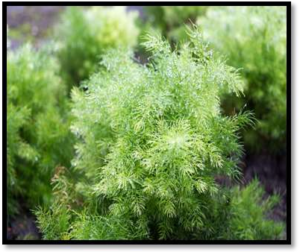
Fig. 1: Shatavari plant (A. racemosus)
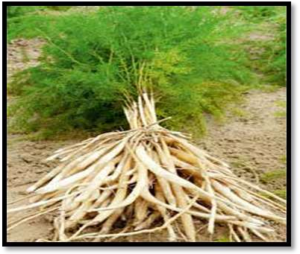
Fig. 2: Shatavari root (A. racemosus)
(Source: http://www.homeremediess.com/medicinal-plants-shatavari-benefits)
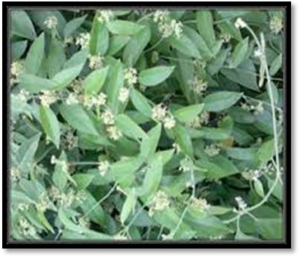
Fig. 3: Jivanti plant (L. reticulata)
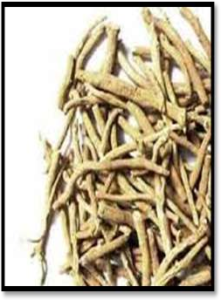
Fig. 4: Jivanti root (L. reticulata)
(Source: http://www.alwaysayurveda.com/leptadenia-reticulata)
Jivanti (Leptadenia reticulata)
Leptadenia reticulata is also known as Jivanti (or Jiwanti) because of its nourishing property for every part of the body. Jivanti specially corrects the metabolism, digestive system and enhance the health status of the body. Indian synonyms of Jivanti are Bhadjivai (in Bengali), Methiododi or Dodi (Gujarati), Dori (Hindi), Hiriyahalle (Kannada), Haranvel (Marathi), Jivanti (Sanskrit) and Kalasa (Telugu). Leptadenia reticulate is belongs to family Asclepiadaceae commonly known as Jivanti. It is distributed in subtropical and tropical parts of Asia and Africa, Burma, Sri Lanka, Malayan peninsula, Philippines, Mauritius and Madagascar. In India, Jivanti is found in Gujarat, Punjab, Himalayan ranges, South India, Sikkim, Deccan and Karnataka. The shape of leaves varies from ovate to cordate, 4 to 8 cm long, 2 to 5.5 cm broad, glabrous above and pubescent below. The roots are very rough, white with longitudinal ridges and furrows and in transverse section the wide cork, lignified stone cell layers and medullary rays can be seen and its size varies from 3 to 10 cm in length and 1.5 to 5 cm in diameter. Leptadenia reticulata is considered to be a tonic (Rasayana) drug and is used to strengthen, nourish and rejuvenate the body (Kirtikar and Basu, 1993). It can be used in treating various body aliments like bleeding disorders, burning sensitivity of the body, pyrexia, cough, dehydration, weak vision and colitis. It possesses the aphrodisiac, astringent, galactogogue, diuretic and used as a tonic in debility (Sonara et al., 2013). Its lactogenic effect has been reported in various domestic animals (Dadarkar et al., 2005). Extracts of roots and leaves of the plant act as antibacterial, antifungal agent and anti abortificient activity (Patel and Dantwala, 1958). Plant possesses the vigorous lactogenic, anabolic and galactogogue effect (Ravishankar and Shukla, 2007).
Leptadenia reticulata contain α-amyrin, β-amyrin, ferulic acid, luteolin, diosmetin, rutin, β-sitosterol, stigmasterol and hentriacontanol (Krishna et al., 1975). Srivastav et al. (1994) reported that leaf of Jivanti contains resins, albuminous, Ca oxalate glucose, carbohydrate and tartaric acid. Hewageegana et al. (2014) reported that the Leptadenia reticulata consist of total ash (16.61%), acid insoluble ash (2.80%), water soluble ash (5.90%), protein (35.80%), crude fat (2.80%), carbohydrates (23.40%), dietary fibre (14.23%), magnesium (1.50%), iron (0.03%) and calcium (0.97%). Supplementation of leptaden tablet consists of Jivanti in buffaloes significantly increased milk yield in field condition (Moulvi, 1963). Feeding of Galactin-Vet bolus in lactating cows improve milk yield of 6.06 per cent during the treatment and 5.48 per cent following the treatment (Sridhar and Bhagawat, 2007). Supplementation of Jivanti in kankrej cows there was non-significantly higher fat yield than control during and post supplementation period (Jain, 2016).
Table 1: Biochemical constituents in root of Shatavari (A. racemosus), leaf/root of Jivanti (L. reticulata) and seed of Methi (T. foenum-graecum).
| Biochemical constituents | Shatavari | Jivanti | Methi | References |
| Protein (%) | 4.60 – 6.10 | 35.80 | 20.0 – 30.0 | Mishra et al. (2005)
Hewageegana et al. (2014) Mehrafarin et al. (2010) |
| Carbohydrates (%) | 36.80 – 47.50 | 23.40 | 45.0 – 60.0 | |
| Crude Fat (%) | – | 2.80 | 6.53 | Hewageegana et al. (2014)
Sinha et al. (2015) |
| Phenol (%) | 3.10 – 5.20 | – | – | Mishra et al. (2005) |
| Tannin (%) | 4.80 – 5.10 | – | – | |
| Saponin (%) | 4.10 | – | 0.60 – 1.70 | Mishra et al. (2005)
Mehrafarin et al. (2010) |
| Total Ash (%) | 13.15 | 16.61 | – | Berhane and Singh (2000) Hewageegana et al. (2014) |
| Calcium (g/100g) | 0.22 | 0.97 | – | |
| Magnesium (g/100g) | 0.40 | 1.50 | – | |
| Potassium (g/100g) | 2.50 | – | – | Choudhary and Kar (1992) |
| Iron (g/100g) | 0.01 | 0.03 | – | Choudhary and Kar (1992)
Hewageegana et al. (2014) |
| Copper (µ/gm) | 5.29 | – | – |
Choudhary and Kar (1992) |
| Zinc (µ/gm) | 53.15 | – | – | |
| Manganese (µ/gm) | 19.98 | – | – | |
| Cobalt (µ/gm) | 22.00 | – | – | |
| Chromium (µ/gm) | 1.81 | – | – |
Methi (Trigonella foenum-graecum)
Fenugreek is a leguminous herb belonging to a fabaceae family that is cultivated in numerous parts of the world predominantly in India, Middle East, North Africa and South Europe. It is cultivated worldwide as a semi-arid crop. It is commonly known as Methi. The seeds are used as a spice and the leaves are consumed as a green vegetable, which are bitter in taste and have been in use for over 2500 years. These seeds are small in size, golden yellow colour and have four faced stone like structure. Raw fenugreek seeds are bitter in taste due to the existence of bitter saponins, which limit their acceptability in foods. India is a major producer and also a chief consumer of fenugreek for cooking uses and medicinal applications (Agrawal et al., 2015). In different languages, it has different names like Fenugrec (French), Methi (Hindi), Pazhitnik (Russian), Fienogreco (Italian), Alholva (Spanish), Koroha (Japanese), Hulba (Arabian), Bockshorklee (German), Halba (Malaya) and K’u-Tou (China).
Fenugreek has an extended history in ayurvedic and Chinese medicine for medicinal purpose and used for several indications such as labour induction, assisting digestion and as a general stimulant to improve health and metabolism. It is one of the most ancient medicinal herbs. It has been used as such for centuries as a purpose of galactogogue. In women, fenugreek is mostly used to increase milk supply (Swafford and Berens, 2000). It provides natural food fibre and other nutrients required in the human and animal body. Fenugreek supports the production of milk because it is a rich source of essential fatty acids (Mowrey, 1986). Most applicable part of
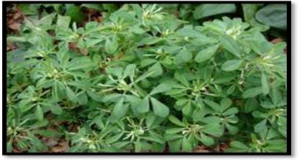
Fig. 5: Fenugreek plant (T. foenum-graecum)
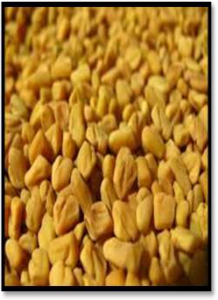
Fig. 6: Fenugreek seed (T. foenum-graecum) (Source: http://www.britannica.com/plant/fenugreek)
Fenugreek (as spice and medicinal purpose) is the seed (Sharma, 1986). Its leaves and seeds have been used widely to prepare extracts and powders for medicinal uses (Basch et al., 2003). The leaves and seeds have anti- diabetic, anti-cancer, anti-microbial, anti-parasitic and procholesterolaemic effects (Al-Habori and Raman, 2002). It is also a tremendous source of selenium, an anti-radiant which helps the body for utilization of oxygen. They are rich in vitamins such as thiamine, folic acid, riboflavin, niacin, vitamins A, B6, K and C, and are a rich source of many minerals such as copper, potassium, calcium, iron, selenium, zinc, manganese, and magnesium. Fenugreek has been used traditionally by mothers to increase the production of breast milk and quicken milk flow while nursing and breastfeeding (Toshiyuki et al., 2000). Also, this herb has been shown to significant effect on the lactation performance in ruminants (Alamer and Basiouni 2005). The biological and pharmacological actions of fenugreek are associated with the variety of its constituents namely steroids, N- compounds, polyphenolic substances volatile constituents, amino acids, etc (Mehrafarin et al., 2010). Supplementation of dairy ration, with fenugreek seeds improves the composition of cow milk (Shah and Mir, 2004). Sayed et al. (2005) mentioned that the fenugreek seed contains phytoestrogens, which are plant chemicals similar to the female sex hormone estrogen, a key compound, diosgenin, has been shown experimentally to upsurge milk flow.
Fenugreek seed contains 45 to 60 per cent carbohydrates mainly mucilaginous fibre (galactomannans), 20-30 per cent proteins high in lysine and tryptophan, 5 to 10 per cent fixed oils (lipids), calcium, iron, saponins (0.6-1.7%), cholesterol, sitosterol, vitamins A, B1, C and nicotinic acid (Mehrafarin et al., 2010). Sinha et al. (2015) reported that the T. foenum-graecum seed is excellent source of protein (20-30%) high in tryptophan and lysine; free amino acids i.e. 4-hydroxyisoleucine, arginine, lysine and histidine (25.80%), fat (6.53%), ash content (3.26%), crude fibre (6.28%), energy (394.46 Kcal/100g seed) and moisture (11.76 %). Supplementation of fenugreek seeds powder @ 60 g per day in goats for seven weeks significantly increased milk production by 13 per cent ( Alamer and Basiouni, 2005). Adding of fenugreek seed at different dose rate 2.5 and 5 g/kg body weight for 7 weeks in ewes significantly increase milk yield and body weight gain (Hassan et al., 2012). Feeding of fenugreek seeds at different levels 5, 10 and 15 per cent of basal diets significantly increased feed intake and milk yield. When fenugreek seed supplement was increased, it is concomitant decrease in milk fat percentage and inconsistent pattern in protein, lactose and SNF (Elmnan et al., 2013). Supplementation of polyherbal combination which contains fenugreek in lactating dairy goats after 2 weeks of kidding for a period of 12 weeks significantly improve milk yield (Galbat et al., 2014). Feeding of fenugreek seed to basal ration at level 0.6 and 1.2 g/kg body weight in lactating ewe’s significantly increased daily feed intake, daily milk yield, milk protein and solid non-fat percentage while the percentage of fat and lactose were significantly decreased (Al-Sherwany, 2015).
It is concluded that Shatavari (Asparagus racemosus), Jivanti (Leptadenia reticulata) and Methi (Trigonella foenum-graecum) are effective herbal galactogogue and its uses as feed additive in dairy animals improve livestock performance in general and milk production in particular. Now a day’s increasing the demand of organic food and cost effectiveness in the livestock feed, the use of herbal feed additives has become the requirement of recent modalities. Utilization of herbal remedies will not only improve the productive efficiency but improve reproductive efficiency, general health and milk production.
DR PRASHANT YOGI, ORGANIC DAIRY CONSULTANT,PUNE
References
- Agrawal, R.S., Shirale, D.O., Syed, H.M. and Syed, A.A.R. (2015). Physico-chemical properties of fenugreek (Trigonella foenum-graceum L.) International Journal of Latest Technology in Engineering, Management and Applied Science. 4(10): 68-70.
- Alamer, M.A. and Basiouni, G.F. (2005). Feeding effects of fenugreek seeds (Trigonella foenum-graecum L.) on lactation performance, some plasma constituents and growth hormone level in goats. Pakistan Journal of Biological 8(11): 1553-1556.
- Al-Habori, M. and Roman, A. (2002). Pharmacological properties in fenugreek- The genus Trigonella. 1st G.A. Petropoulos (Ed.), Taylor and Francis, London and New York, p. 163-182.
- Al-Sherwany. D.A.O. (2015). Feeding effects of fenugreek seeds on intake, milk yield, chemical composition of milk and some biochemical parameters in Hamdaniewes. Al-Anbar Journal of Veterinary Sciences. 8(1): 49-54.
- DADF (2015). Milk Production. In: Annual Report 2014-15. Department of Animal Husbandry, Dairying and Fisheries, Ministry of Agriculture, of India, New Delhi, p. 4-5.
- Bakshi, P.S. and Wadhwa, M. (2000). Feed additives that modify animal performance. In: Rumen Microbinl Ecosystem and its Manipulation Techniques (Eds. D.N. Kamra, L.C. Choudhary and N. Aggarwal), Indian Veterinary Research Institute, lzatnagar, India, p. 125-134.
- Bakshi, M.P.S., Rani, N., Wadhwa, M. and Kaushal, S. (2004). Impact of herbal feed additives on the degradability of feed stuffs in vitro. Indian Journal of Animal Nutrition. 21(4): 249-253.
- Basch, C., Ulbricht, G., Kuo, P., Szapary and Smith M. (2003). Therapeutic applications of fenugreek.
Alternative Medicine Review. 8: 20-27.
- Berhane, and Singh, V.P. (2000). Effect of feeding indigenous galactopoietic feed supplements on milk production in crossbred buffalos. Indian Journal of Animal Sciences. 72(7): 609-611.
- Chopra, and Simon, D. (2000). The Chopra Center.Herbal Handbook. Three Rivers Press, New York, 219: 73-75.
- Choudhary, K. and Kar, A. (1992). Mineral contents of Asparagus racemosus. Indian Drugs. 29: 623.
- Dadarkar S.S., Deore M.D., Gatne, M.M. (2005). Preliminary evaluation of a polyherbal formulation for its galactogogue properties in primiparousWistar rats. Journal of Bombay Veterinary College. 13(2): 50-
- Elmnan, B.A., Jame, N.M., Rahmatalla, S.A., Amasiab, E.O. and Mahala, A.G. (2013). Effect of fenugreek (Trigonella foenum-graecum) seeds supplementaion on feed intake, some metabolic hormones profile, milk yield and composition of Nubian goats. Research Journal of Animal Sciences. 7(1): 1-5.
- Gabay, M.P. (2002). Galactogogues: Medications that induce lactation. Journal of Human Lactation. 18(3):
- Galbat S.A., El-Shemy A., Madpoli A.M., Omayma M.A.L., Maghraby, E.I. and El-Mossalam. (2014). Effects of some medicinal plants mixture on milk performance and blood components of Egyptian dairy Middle East Journal of Applied Sciences. 4(4): 942-948.
- Hassan, S.A.A., Shaddad, S.A.I., Salih, K., Muddathir, A., Kheder, S.I. and Barsham, M.A. (2012). Effects of oral administration of (Fenugreek seeds) on galactagogue, body weight and hormonal Trigonella foenum-graecum levels in Sudanese desert sheep. Journal of pharmaceutical and biomedical Sciences. 22(22): 1-5.
- Hewageegana, S.P., Arawwawala, M., Dhammaratana, I., Ariyawansa, H. and Tisser, A. (2014). Proximate analysis and standardization of leaves: Leptadenia reticulata (Retz) wight and Arn (Jeevanti). World Journal of Pharmaceutical Research. 3(10): 1603-1612.
- Jain, M. and Bais, B. (2016).Effect of Jiwanti (Leptadenia reticulata) supplementation on fat percentage and fat yield of milk produced by Kankrej cows in arid zone of Rajasthan, India. Research and Reviews: Journal of Veterinary Sciences. 2(1): 1-3.
- Kirtikar, K.R. and Basu, B.D. (1993). Indian Medicinal Plants, Vol. 2. International Book Publisher, Dehradun, 898-900.
- Krishna, L., Swarup, D. and Patra, R.C. (2005). An overview of prospects of ethano-veterinary medicine in Indian Journal of Animal Science. 75(12): 1481-1491.
- Krishna, P.V., Rao, E.V. and Rao, D.V. (1975). Crystalline principles from the leaves and twigs of Leptadenia reticulata. Planta Medica. 27: 395-400.
- Kumar, , Mehla, R.K. and Dang, A.K. (2008). Use of Shatavari(Asparagus racemosus) as a galactopoietics and therapeutic herb- a review. Agricultural Review. 29(2): 132-138.
- Mehrafarin, A., Qaderi, A., Rezazadeh, S., NaghdiBadi, H., Noormohammadi, G. and Zand, E. (2010). Bioengineering of important secondary metabolites and metabolic pathways in fenugreek (Trigonella foenum-graecum L.). Journal of Medicinal Plants. 9(35): 1-18.
- Mishra, A., Niranjan, , Tiwari, S. K., Prakash, D. and Pushpangadan, S. (2005). Nutraceutical composition of Asparagus racemosus (Shatavari) grown on partially reclaimedsodic soil. Journal of Medical Aroma and Plant Science. 27(3): 240-248.
- Moulvi, V. (1963). Lactogenic properties of Leptaden. Indian Veterinary Journal. 40: 657.
- Mowrey, B. (1986). The scientific validation of herbal medicine. New camaan, Keats, p. 276-293.
- Patel, R.P. and Danwala, A.S. (1958). Antimicrobial activity of Leptadenia reticulata. Indian Journal of Pharma 20: 241-244.
- Ramesh, P.T., Mitra, S.K., Suryanarayna, T. and Sachan, A. (2000). Evaluation of Galactin, a herbal galactagogue preparation in dairy Veterinarian. 2(4): 1-3.
- Ravikumar, B.R. and Bhagwat, V.G. (2008). Study of the influence of Galactin Vet Bolus on milk yield in lactating dairy Livestock Line. p. 5-7.
- Ravishankar, and Shukla. (2007). Indian systems of medicine: a brief profile. African Journal of Traditional, Complementary and Alternative Medicines. 4(3): 319-337.
- Sayed, M.A.M., Azoz, A.A., El-Maqs, A.A. and Adel-Khalek, A.M. (2005). Some performance aspects of Doe rabbits fed diets supplemented with fenugreek and aniseed. Egyptian Journal of Rabbit Science. 7(3): 147-153.
- Shah, M.A. and Mir, P.S. (2004). Effect of dietary fenugreek seed on dairy cow performance and milk Canadian Journal of Animal Science. 84: 725-729.
- Sharma, A. (2010). Influence of polyherbalimunomodulator supplementation on production performance and milk quality of Karanfries cows. Ph.D. Thesis, National Dairy Research Institute, Karnal, Haryana,
- Sharma, D. (1986). Effect of fenugreek seed and leaveson blood glucose and serum insulin responses in
- human Nutrtional Research. 6: 1353-1364.
- Singh, P., Mehla, R.K. and Singh, M. (2012). Plasma hormones, metabolites, milk production,and cholesterol levels in Murrah buffaloes fed with Asparagus racemosus in transition and postpartum period. Tropical Animal Health Production. 44: 1827-1832.
- Sinha, R., Rauniar, G.P., Panday, D.R. and Adhikari, S. (2015). Fenugreek: pharmacological actions. World Journal of Pharmacy and Pharmaceutical 5(1): 1481-1489.
- Somkuwar, A.P.,Khadtare, C.M., Pawar, S.D. and Gatne, M.M. (2005). Influence of Shatavari feeding on milk production in Pashudhan. 31(2): 3.
- Sonara, B.,Saralaya, M.G. and Gheewala, N.K. (2013). A Review on Phytochemical and Pharmacological Properties of Leptadenia reticulata (Retz) Wight and Arn. Pharma Science Monitor: An International Journal of Pharmaceutical Sciences. 4(1): 3408-3417.
- Sridhar, N.B. and Bhagwat, V.G. (2007). Study to assess the efficacy and safety of Galactin Vet bolus in lactating dairy Mysore Journal of Agricultural Sciences. 41(4): 496-502.
- Srivastav, , Deepak, D. and Khare, A. (1994). Three novel pregnane glycosides from Leptadenia reticulate
wight and Arn. Tetrahedron. 50: 789-798.
- Sukanya, T.S., Rudraswamy, M.S. and Bharathkumar, T.P. (2014). Performance of Shatavari based herbal galactogogue- Milkplus supplementation to crossbred cattle of Malnad region. International Journal of Science and 5(2): 362-363.
- Swafford, and Berens, B. (2000). Effect of fenugreek on breast milk production. Annual meeting abstracts. ABM News and Views, 6(3): 10-12
- Tanwar, P.S., Rathore, S.S. and Kumar, Y. (2008). Effect of Shatavari (Asparagus recemosus) on milk production in dairy Indian Journal of Animal Research. 42(3): 232-233.
- Toshiyuki, , Akinobu, K., Hisashi, M. and Masayuki, Y. (2000). Medicinal Foodstuffs. XVII. 1) Fenugreek seeds. 3) structures of New furostanol- Type Steroid Saponins, Trigoneosides Xa, Xb, XIb, XIIa, XIIb and XIIIa from the Seeds of Egyptian Trigonella foenum-graecum L. Chemical and Pharmaceutical Bulletin. 48(7): 994-1000.
- Uegaki, R., Ando, S., Ishida, M., Takada, D., Shinokura, K. and Kohchi, Y. (2001). Antioxident activity of milk from cows fed Nippon Nogeikagaku Kaishi. 75(6): 669-671.
- Visavadiya, N.P. and Narasimhacharya (2005). Hypolipidimic and antioxidant activities of Asparagus racemosus in hypercholestremic rats. Indian Journal of Pharmacology. 37: 376-380.


